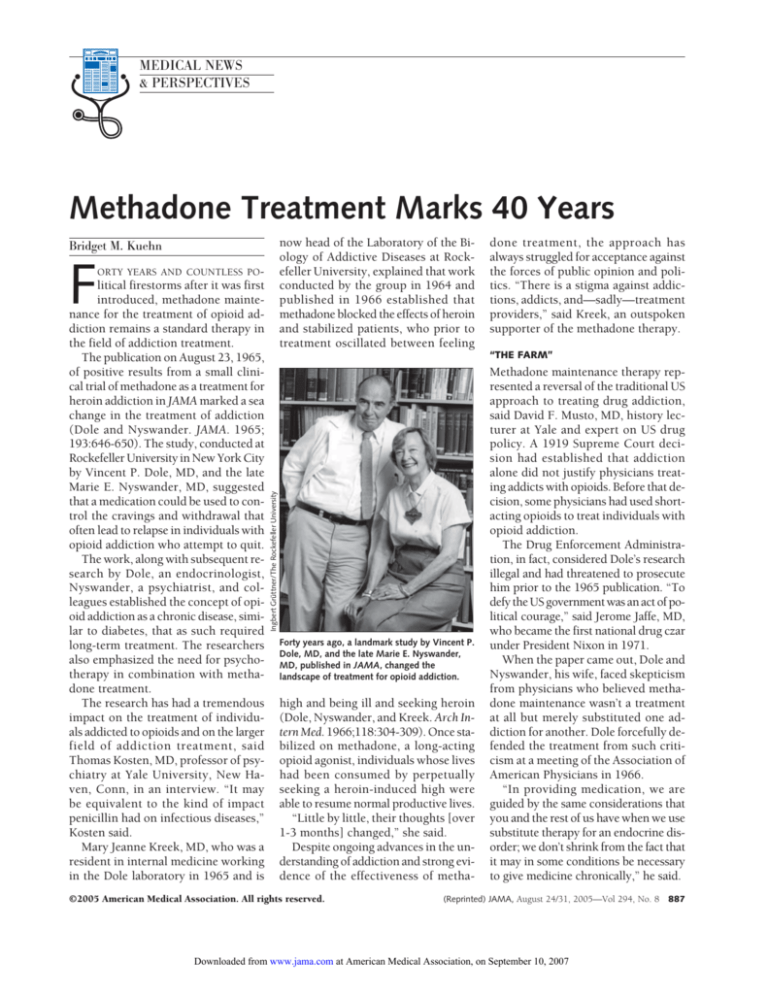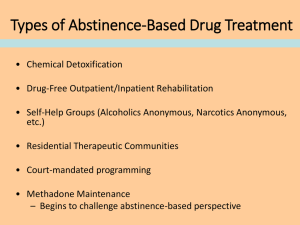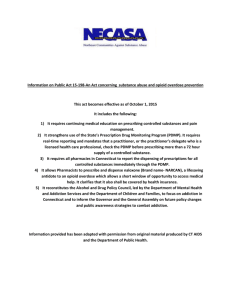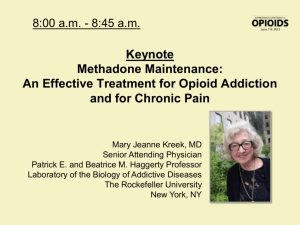
MEDICAL NEWS
& PERSPECTIVES
Methadone Treatment Marks 40 Years
now head of the Laboratory of the Biology of Addictive Diseases at Rockefeller University, explained that work
conducted by the group in 1964 and
published in 1966 established that
methadone blocked the effects of heroin
and stabilized patients, who prior to
treatment oscillated between feeling
Bridget M. Kuehn
F
“THE FARM”
Ingbert Grüttner/The Rockefeller University
ORTY YEARS AND COUNTLESS POlitical firestorms after it was first
introduced, methadone maintenance for the treatment of opioid addiction remains a standard therapy in
the field of addiction treatment.
The publication on August 23, 1965,
of positive results from a small clinical trial of methadone as a treatment for
heroin addiction in JAMA marked a sea
change in the treatment of addiction
(Dole and Nyswander. JAMA. 1965;
193:646-650). The study, conducted at
Rockefeller University in New York City
by Vincent P. Dole, MD, and the late
Marie E. Nyswander, MD, suggested
that a medication could be used to control the cravings and withdrawal that
often lead to relapse in individuals with
opioid addiction who attempt to quit.
The work, along with subsequent research by Dole, an endocrinologist,
Nyswander, a psychiatrist, and colleagues established the concept of opioid addiction as a chronic disease, similar to diabetes, that as such required
long-term treatment. The researchers
also emphasized the need for psychotherapy in combination with methadone treatment.
The research has had a tremendous
impact on the treatment of individuals addicted to opioids and on the larger
field of addiction treatment, said
Thomas Kosten, MD, professor of psychiatry at Yale University, New Haven, Conn, in an interview. “It may
be equivalent to the kind of impact
penicillin had on infectious diseases,”
Kosten said.
Mary Jeanne Kreek, MD, who was a
resident in internal medicine working
in the Dole laboratory in 1965 and is
done treatment, the approach has
always struggled for acceptance against
the forces of public opinion and politics. “There is a stigma against addictions, addicts, and—sadly—treatment
providers,” said Kreek, an outspoken
supporter of the methadone therapy.
Forty years ago, a landmark study by Vincent P.
Dole, MD, and the late Marie E. Nyswander,
MD, published in JAMA, changed the
landscape of treatment for opioid addiction.
high and being ill and seeking heroin
(Dole, Nyswander, and Kreek. Arch Intern Med. 1966;118:304-309). Once stabilized on methadone, a long-acting
opioid agonist, individuals whose lives
had been consumed by perpetually
seeking a heroin-induced high were
able to resume normal productive lives.
“Little by little, their thoughts [over
1-3 months] changed,” she said.
Despite ongoing advances in the understanding of addiction and strong evidence of the effectiveness of metha-
©2005 American Medical Association. All rights reserved.
Methadone maintenance therapy represented a reversal of the traditional US
approach to treating drug addiction,
said David F. Musto, MD, history lecturer at Yale and expert on US drug
policy. A 1919 Supreme Court decision had established that addiction
alone did not justify physicians treating addicts with opioids. Before that decision, some physicians had used shortacting opioids to treat individuals with
opioid addiction.
The Drug Enforcement Administration, in fact, considered Dole’s research
illegal and had threatened to prosecute
him prior to the 1965 publication. “To
defy the US government was an act of political courage,” said Jerome Jaffe, MD,
who became the first national drug czar
under President Nixon in 1971.
When the paper came out, Dole and
Nyswander, his wife, faced skepticism
from physicians who believed methadone maintenance wasn’t a treatment
at all but merely substituted one addiction for another. Dole forcefully defended the treatment from such criticism at a meeting of the Association of
American Physicians in 1966.
“In providing medication, we are
guided by the same considerations that
you and the rest of us have when we use
substitute therapy for an endocrine disorder; we don’t shrink from the fact that
it may in some conditions be necessary
to give medicine chronically,” he said.
(Reprinted) JAMA, August 24/31, 2005—Vol 294, No. 8
Downloaded from www.jama.com at American Medical Association, on September 10, 2007
887
MEDICAL NEWS & PERSPECTIVES
Others criticized the lack of controls in the study. However, Dole
pointed out that in Nyswander’s more
than 20 years of experience treating individuals with heroin addictions, she
had made many efforts to treat her patients without medication, some of
whom she later successfully treated with
methadone. “She had very little doubt
that the medication plays an essential
role,” Dole said.
The scientists also faced some resistance from within the addiction treatment community, which would compete with the methadone maintenance
approach for funds and political support, Jaffe said. An array of treatments
were in use at the time, including
therapeutic communities and detoxification. Civil commitment, which was
essentially prison camp, was a popular
treatment. One such program, known
as “the Farm,” was operated by the US
Public Health Service, in Lexington,
Ky. Despite growing political and
popular support for such programs,
however, relapse rates were high after
release.
The approach also met resistance by
some minority communities, which
were suspicious that the treatment was
an attempt to damage or kill minorities, Musto said.
As expanded clinical trials showed
more positive results and more physicians gained experience with the treatment, methadone maintenance gained
some momentum. But while thousands of heroin addicts were being
treated with methadone by 1970, the
approach was still considered experimental and the federal government began establishing strict controls of
methadone treatment programs, according to Jaffe.
In 1971, however, growing public
concern over the numbers of Vietnam
veterans returning to the United States
addicted to heroin prompted the government to establish the Special Action Office of Drug Abuse Prevention
and appoint Jaffe to lead the organization. Over the next 3 years, Jaffe established a nationwide network of methadone treatment clinics.
The emergence of AIDS in the 1980s
gave new urgency to the need to treat
individuals with opioid addictions,
among whom the infection spread by
sharing contaminated needles. Kreek’s
laboratory was the first to identify HIV
among heroin users. Using blood
samples dating back to 1969, collected to study hepatitis B, her group
found that the virus had begun circulating among intravenous heroin users by 1978; by 1981, half of those seeking treatment for heroin addiction at
Rockefeller University were HIVpositive, Kreek said. A July 13, 1984,
report detailed the high prevalence of
HIV among intravenous heroin users in
New York and noted that rates were
lower among those in long-term methadone treatment (MMWR Morb Mortal
Wkly Rep. 1984;33:377-379).
Public support for methadone treatment had waned somewhat in the years
before AIDS emerged, but because
methadone treatment is seen as one of
the more effective ways to curb the
spread of HIV infection by reducing intravenous drug use, some support has
returned, Musto said.
BRAIN DISORDER
Detoxification remains a common treatment for opioid addiction, despite high
dropout rates and patient discomfort.
(The results of a clinical trial of anesthesia-assisted detoxification and an accompanying editorial appear in this issue of JAMA [see pages 903 and 961].)
However, since the publication of the
1965 methadone trial, the field of addiction treatment has advanced considerably. Scientists now have remarkably detailed knowledge of the biology
of drug addiction, down to the chemical structure of opioid drugs and the
brain receptors they bind to.
“We know the agent, we know the
part in your brain that it hits, we know
it in exquisite molecular detail, and it
makes intelligent hypothesis-driven
medicine very feasible,” Kosten said.
While methadone continues to be an
important treatment for opiate addiction, other therapies have emerged. Buprenorphine, a opioid partial agonist,
888 JAMA, August 24/31, 2005—Vol 294, No. 8 (Reprinted)
is available through a special program
allowing office-based physicians to prescribe an abuse-resistant formulation of
the medication. Naltrexone, an opioid
antagonist that prevents relapse, has
proven to be particularly useful for
treating certain groups, including physicians, nurses, and pharmacists, said
Charles O’Brien, MD, PhD, professor of
psychiatry at the University of Pennsylvania in Philadelphia. Naltrexone has
also been found to reduce relapse rates
among parolees. A monthly injectable
formulation of naltrexone is being considered for approval by the Food and
Drug Administration and a decision is
expected by September, O’Brien said.
Scientists have been able to elucidate the key role that the endogenous
opioid receptor system plays in addiction and are beginning to understand
how genetic and environmental factors contribute to addiction.
“We have very good evidence now
that addiction is a chronic disease,”
O’Brien said. He explained that brain
imaging studies have shown that the
brain is altered by addiction and remains altered for some time after a person stops taking drugs.
Some individuals who develop opioid addictions require long-term treatment. Kosten said some of his patients
have been on methadone for decades
and live productive lives, but if they stop
therapy, “their life becomes chaos.”
For other individuals, brain changes
caused by addiction or other factors
may be reversible. Animal studies have
demonstrated that addiction alters the
brain at the molecular level. With time
and treatment, those changes can be reversed. “You’ve changed the neurobiology, and it takes time to get that back
to normal,” Kosten said.
The discovery that opioid receptors
are also involved in alcoholism led to a
new treatment for that disorder. For
some alcoholics, particularly those with
a family history of alcoholism, naltrexone has proven to be an effective treatment (see JAMA. 2005;293:16171625). O’Brien explained, “There are
certain people when they drink alcohol it’s almost as though they took
©2005 American Medical Association. All rights reserved.
Downloaded from www.jama.com at American Medical Association, on September 10, 2007
MEDICAL NEWS & PERSPECTIVES
heroin because it releases endorphins
or endogenous opioids. That’s why naltrexone helps them because naltrexone blocks those endorphins and
prevents them from getting high on
alcohol.”
Genetic differences appear to play
an important role in addictions; certain individuals may have genes that
make them more vulnerable to devel-
oping addictions, while others may
have genes that are protective, Kreek
said. She said that an estimated 30%
to 50% of the risk of developing an
addiction is genetic and that several
groups of scientists are searching for
the responsible genes.
Understanding these genetic differences will likely revolutionize the way
addiction is treated. “We’ll be able to
treat the patients according to their own
genotype,” O’Brien said.
While the discoveries by Dole’s laboratory clearly laid the groundwork for
many subsequent scientific advances,
some in the field say the work itself
wasn’t the only legacy.
“It wasn’t just science,” said Jaffe. “It
was the courage and commitment of
Vincent Dole.” 䊐
As Tsunami Recovery Proceeds, Experts
Ponder Lessons for Future Disasters
APA’s Council on Global Psychiatry, the
World Psychiatric Association, the
WHO, and the US Centers for Disease
Control and Prevention.
ATLANTA—Several teams of mental
health professionals—few, if any, of
whom spoke any Asian language—
rushed from the United States, Italy,
Sweden, and other countries to Sri
Lanka and Indonesia in early January
to offer counseling to survivors of the
tsunami that had ravaged coastal regions of South Asia and East Africa on
December 26, 2004.
The tsunami had razed homes, hospitals, businesses, schools, roads,
bridges, and communication systems;
destroyed food supplies and crops; contaminated drinking water; and killed
livestock. The visitors needed housing, food, transportation, and translators, all scarce in the aftermath of the
100-foot-high tidal wave that killed at
least 300 000 individuals, injured more
than 500 000, and displaced more than
1 million.
Despite good intentions, “effort does
not equal assistance,” Shekhar Saxena,
MD, coordinator of mental health evidence and research at the World Health
Organization (WHO), Geneva, Switzerland, said at the annual meeting of the
American Psychiatric Association (APA)
here in May. He and other psychiatrists
reported field experiences in tsunamiaffected countries and discussed best
practices for responding to future largescale disasters at a session sponsored by
AP/Wide World Photos
Lynne Lamberg
South Asian countries affected by the tsunami
last December had limited mental health
resources to help survivors deal with
psychological effects of the disaster.
Meaningful help for areas battered by
catastrophes, Saxena said, might include financial support for lengthy
visits by specialists who know local languages and cultures, as well as contributions of needed equipment and supplies or funds for their purchase.
©2005 American Medical Association. All rights reserved.
Even before the disaster, South
Asian countries affected by the tsunami had limited mental health
resources, Saxena noted, with only
one psychiatrist per 300 000 people
on average, typically working in
urban areas. Of the hardest hit countries, Sri Lanka, had 5 resident psychiatrists for the approximately 5 million people living in the coastal areas
pummeled by the tsunami. Indonesia’s Acheh Province had 6 psychiatrists for its 4.5 million people.
Groundwork had been laid, however, for meeting psychosocial needs after a major catastrophe, Saxena said.
The WHO’s 2004 Sphere Handbook includes a chapter on this topic (http:
//www.sphereproject.org/handbook
/index.htm). In addition, a practical
guide to mental health and social interventions and principles for acute
emergencies, in press when the tsunami struck, was distributed quickly to
affected countries (van Ommeren et al.
Bull World Health Organ. 2005;83:7176, available at http://www.who.int
/bulletin/volumes/83/1/71.pdf).
COMMUNITY OUTREACH CRUCIAL
About 4 weeks after the disaster, departments of health in affected South
Asian countries held daylong workshops for medical officers, social workers, teachers, child protection staff, and
others on managing mental health con-
(Reprinted) JAMA, August 24/31, 2005—Vol 294, No. 8
Downloaded from www.jama.com at American Medical Association, on September 10, 2007
889










